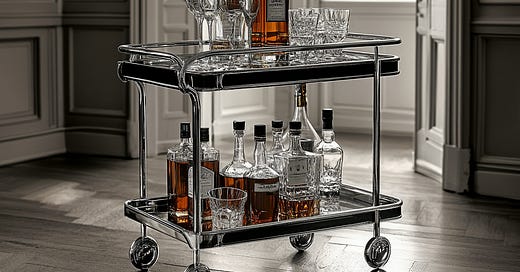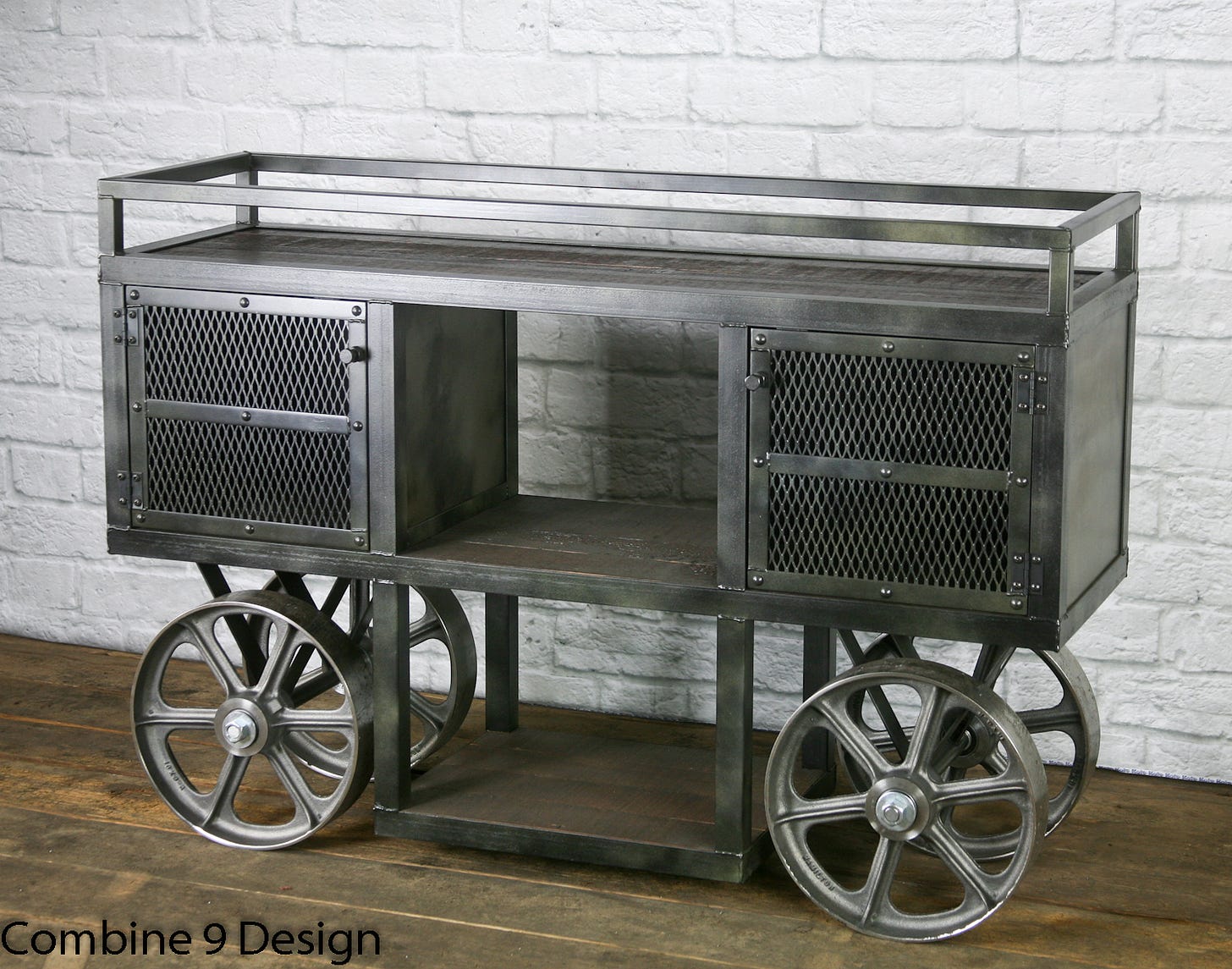The Rise and Fall and Rise of the Bar Cart
Why restaurants should bring back the bar cart (Hint: it’s not for nostalgia)
I recently rewatched the 1955 film “The Seven Year Itch.” The movie is about a New York businessman whose wife and son head off to Maine for the summer, leaving him alone in the sweltering metropolis. As it happens, a single woman sublets the apartment above him. And as it often happens, the single woman is Marilyn Monroe. Temptation happens, hijinks ensue.
I watched it again because I was curious about the bar cart, which plays a supporting role. In one early scene, he invites her down for a drink, where she requests a “big, tall martini.” The businessman, played by Tom Ewell, goes to his handy bar cart, pours her about eight fingers of gin in a collins glass, followed by the daintiest burp of vermouth.
Never mind the drink. (“Maybe it needs a little more sugar,” Monroe suggests after a sip.) Let’s talk about the bar cart.
I was actually disappointed that the cart didn’t get more of a starring role. It wasn’t wheeled out with a flourish. It remained up against a wall in the background. Isn’t wheeling it out the whole point of a bar cart? I mean, it has wheels. A bar cart makes for a dramatic reveal — it has a pleasing audio overture of clanking bottles and tinkling glassware as it makes its way across the room or porch, then with some ceremony it comes to rest like a portable stage, ready for the starring host to slay his guests’ thirst and get the party started.
Even though the “Seven Year Itch” bar cart had the furniture equivalent of a non-speaking role, it still managed to achieve some later fame, like a cast members from ”Gilligan’s Island” signing autographs at malls. In 2002 it went up for auction at Christie’s.and brought $9,560.
That was a pretty good return — given that the same cart could have been had at Dohmann’s department stores in California around the time of the movie for $39.75. (The ad for the cart noted correctly that “This modern bar car moves to and from your party with ease!” Director Billy Wilder should have taken note.)
When and where the bar cart first surfaced is unknown. But we know that its immediate ancestor was the tea trolley, which was popular in England in the late 19th century. (The first known reference to a tea trolley dates to 1807, thank you for asking.)
These wheeled carts could be rolled out at tea time to wherever the guests were seated, preferably by a butler named Jeeves. The tea trolley was a must-have accessory among the British upper crust, and so it soon became a must-have item among the aspiring merchant class. Then Anglophilic and status-conscious Americans decided they should probably have one, too, even if they hated tea.
It may have been around America’s Prohibition that the tea trolley found its new role as a bar cart. It makes sense. A host could keep her glassware and illicit bottles on the cart hidden in a closet or pantry, and then roll it out when friends were gathered, curtains pulled, and doors closed.
After Prohibition, bar carts were used in New York to circumvent a short-lived state ban on bars at hotels. These “strolling bars that wander table to table when the guests beckon... will not be a bar, but a pushcart loaded with liquor,” the Associated Press reported in 1933.
In homes, bar carts became synonymous with a quality life. In 1943 syndicated shopping columnist Helen Hunt reported that she was “turning cartwheels” since she discovered this “snitzy” bar cart that makes “outdoor entertaining a gala event!” (Note: the word “snitzy” arose thanks to a brief marriage between “snazzy” and “ritzy” and I demand that it be brought back into common circulation.)
The aspirational nature of bar carts may have been best summarized in a scene from the cult 1956 movie, “The Bad Seed.” A sodden character played by the great Eileen Heckart regards a bar cart as it rolls by, and exclaims, “Oh, ain’t we swank!”
Thanks to Hollywood, the bar cart became a symbol of the New York and Hollywood elites, but it also proved practical for entertaining in the small homes then being built. In the 1950s, the average home was 1,100 square feet, and so a bar cart could serve as a pop-up rumpus room.
Carts faded from popularity with the decline of cocktail culture in the 1960s and ‘70s, but they’ve lately benefited from a revival in tandem with the cocktail renaissance. The return is in part due to the popularity of “Mad Men,” where day drinking and bar carts were baked into the script. (Side note: Don Draper’s bar cart was presented to the Smithsonian’s National Museum of American History in 2015.)
In the past decade, vintage bar carts have been in demand — eBay had more than 1,600 “vintage bar carts” listed when I last checked, although the definition of “vintage” on eBay tends to be, um, pliable. Retro bar carts are now readily available, including at Pottery Barn, West Elm, and Wayfair.
And some carts are rolling back into bars and restaurants, where they are again aspirational. Fifteen years ago I sat in the snitzy bar at the Connaught Hotel, and the ever-elegant Agostino Perrone wheeled over a martini cart and made bespoke drinks. People around us watched, captivated. Then several summoned him over for their own drinks.
And for bar owners, that may be the best argument for bringing back the bar cart — not just glamor and showmanship and nostalgia. If you run a bar, it’s the financials.
A couple of months back I was talking to Nicholas Palazzi, the owner of PM Spirits, for an article I was writing on the growing rift between craft spirits and craft cocktail bars. He wholesales a line of vermouths, cognacs, fine rums, liqueurs, and other “geeky spirits,” and he’s noticed a decline in bar carts being piloted through restaurants to offer drinks after dinner. He laments their disappearance. “Wheeling a cart through the dining room, the sales of digestifs go through the roof,” he said. “But that’s not done as much now as it used to be.”
Maybe the bar cart needs to move on to its next evolution. My nominee for the bar cart of the future is this one made by Combine 9 in Houston, which has a sort of retro-futuristic, steampunk aesthetic. It’s the Cybertruck of bar carts, if the Cybertruck were designed by H.G. Wells and the company weren’t owned by an alien with a low regard for democracy. It looks as if you should be wearing aviator goggles and a leather flight helmet to be serving from it.
And it does what bar carts were always meant to do: Make drinking dramatic again.







